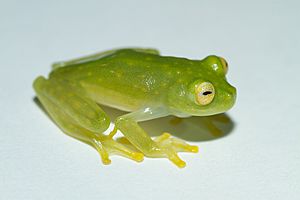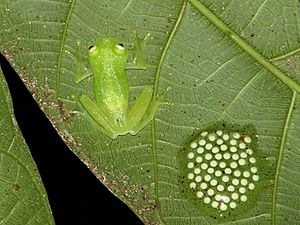Bare-hearted glass frog facts for kids
Quick facts for kids Bare-hearted glass frog |
|
|---|---|
 |
|
| Conservation status | |
| Scientific classification | |
| Synonyms | |
|
Centrolenella colymbiphyllum Taylor, 1949 |
The Hyalinobatrachium colymbiphyllum, also known as the bare-hearted glass frog, plantation glass frog, or cricket glass frog, is a type of frog. It belongs to the Centrolenidae family. These frogs live in wet forests, often near streams, in parts of Central America and South America. They are small, green frogs. They look a lot like other glass frogs. However, their undersides are the most see-through of all glass frogs. Because their skin is so clear, scientists can study them easily. This makes them good "bio-indicators." This means they help show how things like global warming are affecting animals in the forests.
Contents
What Makes Them Special?
Bare-hearted glass frogs look similar to most glass frogs. But they have some unique features. Like many glass frogs, they are small and green. They often have yellow spots. Their undersides are clear, which is a main feature of glass frogs. The bare-hearted glass frog has the clearest underside. You can almost see all their inside organs!
Their clear skin and small size make them hard to spot. Male frogs are about 22–27 mm (0.87–1.06 in) long. Females are a bit bigger, around 24.5–29 mm (0.96–1.14 in) long. They have golden eyes that face forward. Their nostrils stick up a bit from their heads.
These frogs move around in forests and streams. Their front fingers are not very webbed. This helps them climb trees. Their back feet are very webbed. This helps them swim well in water.
Baby bare-hearted glass frogs, called tadpoles, are very tiny. They are less than 9.5 mm (0.37 in) long. They are brown with light undersides. They have long bodies and pointed tails. This shape helps them swim while they grow in the streams.
Where Do They Live?
The bare-hearted glass frog is found in several countries. These include Honduras (in the Olancho Department), central and southeastern Costa Rica, Panama, and western Colombia. They live along the western slopes of the Cordillera Occidental mountains.
They like to live near streams or other water bodies. These areas are usually surrounded by rainforests. During the time they lay eggs, they live on leaves or bushes. These plants hang over the water. This way, when the eggs hatch, the tiny tadpoles can drop right into the stream.
The Costa Rican Amphibian Research Center (CRARC) has studied these frogs. They found that when it's not breeding season, the frogs live higher in trees or near waterfalls. Scientists don't know exactly what they eat. But like most frogs, they probably eat small insects.
Threats to Their Home
These frogs need trees to live. So, they are most in danger from deforestation. This is when forests are cut down. Even though their home is threatened, the International Union for Conservation of Nature says they are "least concern" for extinction. This means they are not in immediate danger of disappearing.
However, many other glass frog populations are shrinking. This means bare-hearted glass frogs could also be at risk in the future. Global warming is another threat. These frogs need moisture and rain to stay healthy. If there isn't enough rain or if conditions get too warm, it can be dangerous for them.
Scientists are very interested in studying bare-hearted glass frogs. They can be good "bio-indicators." This means they help show how global warming is affecting not just frogs, but other animals in rainforests too. Also, scientists are learning more about how other animals eat these glass frogs. For example, a type of snake called the Ornate Cat-eyed snake eats glass frogs, their eggs, and tadpoles in Costa Rica.
Reproduction and Life Cycle
Breeding season for these frogs is during the rainy season. This is usually from late fall to spring. The breeding process starts when male frogs pick a leaf or bush near a stream. This is their "calling ground." They make calls to attract females. Their call sounds like a cricket, which is how they got one of their common names.
Males stay in one spot to call. They will fight other males for their chosen leaf. They also fight to win females. These fights are usually about a specific leaf or calling area. The male who pins the other male down wins.
Once a male attracts a female, she lays her eggs on the underside of a leaf. A group of eggs, called a clutch, usually has 50 to 75 eggs. These eggs are laid under leaves that hang over streams. The male frog then takes care of the eggs. His job is to protect them and keep them moist. He does this by urinating on them and through osmosis. Osmosis is a process where water passes through his skin to the eggs.
These frogs are nocturnal, meaning they are active at night. The male guards the eggs during the night. But during the day, when the male is not guarding, wasps can steal the eggs. Wasps can take one egg at a time or even an entire clutch. The eggs stay on the leaf and grow for about two weeks.
When the eggs hatch, the tiny tadpoles wiggle until they drop into the streams. Sometimes, rain washes them off the leaves into the water. Once in the stream, they finish growing into frogs. Scientists have also seen male glass frogs make special choices if there are problems with the eggs. For example, if some eggs are at risk of drying out or getting sick, the male might decide to remove those eggs to protect the others. Or, he might try a "rescue strategy" to save them.
See also
 In Spanish: Hyalinobatrachium colymbiphyllum para niños
In Spanish: Hyalinobatrachium colymbiphyllum para niños




